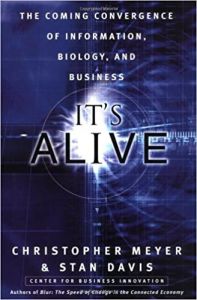Why we are on the cusp of a new economic era that will make the changes and challenges of the Information Era seem like child's play
From the bestselling authors of Blur—a defining book of the Information Age—comes a startling glimpse into the near future and the emerging economy that awaits us. It's Alive foretells the jolt the world is about to receive as the science of molecular evolution races out of the laboratories and into the business world.
Think back to the early 1970s. Imagine the opportunities for your business, career choice, and investments had you received an advance report on the ways in which computer and information technology would revolutionize the world. It's Alive provides that opportunity today: a realistic and persuasive look into the future—the molecular economy—and how it is starting to overtake and reshape the Information Age. Today's gene mapping and molecular engineering are equivalent to the introduction of transistor radios at the advent of the information economy. Solid-state technology moved from the labs into the business arena, providing in turn the transistor, the microprocessor, and the modem—and the information business. During the next ten years, molecular technology will follow the same pattern, moving from the lab and into the basic operation of the corporation itself.
Chris Meyer and Stan Davis are our guides in understanding this new future. They show that not only biological systems evolve. The rules of evolution help explain the process of change in biology, business, and the economy, thereby providing a management guide to the business world around the corner.
It's Alive is not science fiction or futurism. It bases its insights and predictions on the impact the molecular economy is already having in such diverse business environments as manufacturing, financial services, and energy. Through in-depth case studies of Capital One Financial, the U.S. Marine Corps, British Petroleum, and the biotech firm Maxygen, Meyer and Davis show how adaptive behavior works in the real world. As the rules of evolution combine with the connected economy, our business world will become unpredictable, volatile, and continually adaptive—in other words, alive.
Editorial Reviews
From Publishers Weekly
The hackneyed trope of businesses as organisms in an economic ecosystem is updated in this informative but puffed-up volume of management theory. According to Meyer and Davis, authors of the New Economy manifesto Blur: The Speed of Change in the Connected Economy, the next big thing will be a "molecular economy"-biotechnology, nanotechnology and materials science-based on biological processes or things that mimic them. They spend several chapters on a tour of up-and-coming technologies, but their interest in them is mainly as avatars of a new managerial zeitgeist. In a coming age of unprecedented "volatility," businesses must abandon efforts to craft the perfect plan for the future and engineer the environment, and should instead embrace an evolutionary paradigm of "adaptive management" based on biological principles. Successful organizations must "self-organize" instead of relying on command-and-control, "recombine" best practices from diverse sources, "sense and respond" to changing conditions, "seed, select and amplify" a multitude of innovations and constantly "destabilize" themselves. Drawing on case studies of organizations including the Capital One credit card company and the Marine Corps, the authors apply these insights to basic business functions like inventory, pricing, product development and Web services. Their fluent, breathless style, replete with outré theorizing, maintains a relentless tone of future-shock over developments that are mostly high-tech extensions of age-old business practices. While some of their farther-out prognostications-e.g., virtual-reality "experience machines"-may prove that nothing gets dated faster than futurism, there are enough pragmatic applications here for alert executives to chew on. 18 line drawings.
Copyright 2003 Reed Business Information, Inc.
Review
"Holy cow! Integrating biology, management, nanotech, and evolution—if you loved James Gleick's Chaos, you'll love It's Alive."—SETH GODIN, author of Survival is Not Enough
"Clearly captures the profound impact that biologically inspired technology and technology-infused biology will have on every aspect of our economy and society." —RAY KURZWEIL, inventor and author of The Age of Spiritual Machines
"The book to read for anyone concerned about business innovation at a time when nothing seems to be going right."—Antonio Damasio, Van Allen Professor of Neurology, University of Iowa, and author of Looking for Spinoza
"Read this exciting and sweeping book to regrind your own conceptual lenses for understanding business in the twenty-first century—the age of discontinuity."—JOHN SEELY BROWN, former director of Xerox PARC
"The Web is marrying the biological revolution and driving change in one industry after another. Chris Meyer and Stan Davis not only describe the coming revolution but provide a plan for prospecting in it."—Juan Enriquez, director of the Life Sciences Project,
Harvard Business School, and author of As the Future Catches You
"A CEO-level guide to the forces reshaping our economy. Meyer and Davis have created an essential tool kit for future growth."—Mick Yates, former group chairman, Johnson & Johnson Consumer
From the Inside Flap
Why we are on the cusp of a new economic era that will make the changes and challenges of the Information Era seem like child?s play
From the bestselling authors of Blur?a defining book of the Information Age?comes a startling glimpse into the near future and the emerging economy that awaits us. It?s Alive foretells the jolt the world is about to receive as the science of molecular evolution races out of the laboratories and into the business world.
Think back to the early 1970s. Imagine the opportunities for your business, career choice, and investments had you received an advance report on the ways in which computer and information technology would revolutionize the world. It?s Alive provides that opportunity today: a realistic and persuasive look into the future?the molecular economy?and how it is starting to overtake and reshape the Information Age. Today?s gene mapping and molecular engineering are equivalent to the introduction of transistor radios at the advent of the information economy. Solid-state technology moved from the labs into the business arena, providing in turn the transistor, the microprocessor, and the modem?and the information business. During the next ten years, molecular technology will follow the same pattern, moving from the lab and into the basic operation of the corporation itself.
Chris Meyer and Stan Davis are our guides in understanding this new future. They show that not only biological systems evolve. The rules of evolution help explain the process of change in biology, business, and the economy, thereby providing a management guide to the business world around the corner.
It?s Alive is not science fiction or futurism. It bases its insights and predictions on the impact the molecular economy is already having in such diverse business environments as manufacturing, financial services, and energy. Through in-depth case studies of Capital One Financial, the U.S. Marine Corps, British Petroleum, and the biotech firm Maxygen, Meyer and Davis show how adaptive behavior works in the real world. As the rules of evolution combine with the connected economy, our business world will become unpredictable, volatile, and continually adaptive?in other words, alive.
Also available as an eBook.
From the Back Cover
"Holy cow! Integrating biology, management, nanotech, and evolution—if you loved James Gleick's Chaos, you'll love It's Alive."—SETH GODIN, author of Survival is Not Enough
"Clearly captures the profound impact that biologically inspired technology and technology-infused biology will have on every aspect of our economy and society." —RAY KURZWEIL, inventor and author of The Age of Spiritual Machines
"The book to read for anyone concerned about business innovation at a time when nothing seems to be going right."—Antonio Damasio, Van Allen Professor of Neurology, University of Iowa, and author of Looking for Spinoza
"Read this exciting and sweeping book to regrind your own conceptual lenses for understanding business in the twenty-first century—the age of discontinuity."—JOHN SEELY BROWN, former director of Xerox PARC
"The Web is marrying the biological revolution and driving change in one industry after another. Chris Meyer and Stan Davis not only describe the coming revolution but provide a plan for prospecting in it."—Juan Enriquez, director of the Life Sciences Project,
Harvard Business School, and author of As the Future Catches You
"A CEO-level guide to the forces reshaping our economy. Meyer and Davis have created an essential tool kit for future growth."—Mick Yates, former group chairman, Johnson & Johnson Consumer
About the Author
Christopher Meyer is the director of the Center for Business Innovation in Cambridge, Massachusetts, a business research and consulting group supported by Adventis and Cap Gemini Ernst & Young. He is also a founder of the BIOS Group, a firm created to develop adaptive software solutions for management, and the coauthor (with Stan Davis) of Blur and Future Wealth.
Stan Davis is an independent Boston-based scholar, consultant, and public speaker and a senior fellow of the Center for Business Innovation. He is the author of Future Perfect and coauthor of 2020 Vision.
Excerpt. © Reprinted by permission. All rights reserved.
1
Economic Evolution: Learning from Life Cycles
Imagine that it's 1971 in Palo Alto, California.
You've wandered into a building at the Stanford Industrial Park, a nondescript place with cinder-block walls and rented furniture. The 3180 Porter Drive site is as plain and drab as the surface of the moon, and the guys working here seem to be living in their own private universe, speaking their own unique language. Someone's nattering on about the new "Intel 4004." Apparently, this new gadget he's talking about is called a "microprocessor." Someone else seems to think it's really great that this thing contains 2,250 transistors. They're both worked up over the fact that this "microprocessor" has an entire "CPU" on a single "chip."
As an average person living in 1971, you have no idea what they're talking about. In this ugly building on Porter Drive, also known as the Xerox Palo Alto Research Center (PARC), the computer wonks are also talking about "operating systems" and "laser printing" and "icons." Soon they will be going on about the "mouse," "point and click," and the "graphical user interface"; eventually, "bandwidth" and "network protocols."
In the early seventies, these terms were arcane jargon, but the words and the concepts they represent are as familiar to us now as "assembly line" and "mass production" were then. That's because the computer scientists at places like Xerox PARC and Bell Labs were, in fact, inventing the future--which is now our present--building the new economic engine that would overtake the industrial economy of the preceding 150 years. "Computer speak" is the lingua franca of the world we inhabit at the beginning of the twenty-first century.
Today, in commercial laboratories with names like Maxygen, Diversa, and Nanosys, it's happening again. A new generation of scientists is inventing the next new world with its own novel nomenclature. Their terms of art, phrases such as "combinatorial chemistry," "gene shuffling," "high-throughput screening," and "MEMS" sound just as arcane to the average person now as computer terminology did in 1971.
But pay attention. In the same way that researchers at PARC and Fairchild Semiconductor and Bell Labs created technology that established a new economy based on information, scientists in labs today are inventing a future based on molecular technologies. These include not just biotechnology but nanotechnology and materials science as well. Cargill Dow Polymers is growing polymers for plastics in corn plants. PPG Industries is making nano-scale coatings that enable windows to wash themselves in the rain. Bio-Rad Laboratories is attaching naked strands of DNA to gold nanospheres and injecting them into people with a nano-BB gun.
A new "molecular economy" is on its way, while the information economy hasn't completely matured. As the information economy comes of age, a surprising thing is happening: Information systems are starting to take their cues from biological ones. Information is converging with biology, and business is following suit.
At John Deere, for example, the art of breeding--as in thoroughbreds and show dogs--has been used to evolve a schedule for a highly complex factory that makes seed planters. Using a computer, the metal-benders create a few random schedules that express the sequence of planters to be built in a digital code made of zeros and ones. That code is a set of instructions, just as DNA carries a set of instructions, its "genetic code." Deere engineers evaluate each schedule with a simulator, which is like letting the horses grow up, and then racing them--in silico. The winning sequences are then mixed, put out to stud in an approach that is essentially sex for software. Through this approach, which uses a "genetic algorithm," parts of the best schedules are recombined to create a new generation, just as horse genes are recombined, albeit through a somewhat messier process. Forty thousand new schedules run simulated races every night, and the winner is the schedule that runs tomorrow's real-life production derby on the John Deere factory floor.
Genetic algorithms are already in widespread use, improving jet-engine designs, credit-scoring forms, and stock-trading rules. The bigger story than sex for software is the abstract principle that biological behavior--in this case sex--can be written into digital code, then applied to the most intractable business problems. Stay with us, and you'll see that this translation of a biological function into a computer process is only one of many ways in which the concepts of evolution apply to business, in this case through precisely measurable operations improvements.
In 1984, a multidisciplinary group formed the Santa Fe Institute and began a research program based on a really big idea: that biology is not the only system that evolves, and that the concepts of evolution help to explain the process of change in any connected system, be it an ecology or an economy. Since then SFI has extended its work to other social systems--a business, a tribe, a crowd, a stock market, or a political party. Their work (and similar work at the University of Michigan, IBM, and many other places) has created some early tools, and a point of view that lets us see the economy as an ecology, and an organization as an organism, at the level of rigor needed to do empirical science. That's the level at which you begin to use evolutionary concepts to schedule factories.
These techniques, in time, may become as pervasive as the computerized spreadsheet is today. In fact, you can get started on your PC right now with a Microsoft Excel add-on called Evolver.
The theory of evolution through selection goes back to Charles Darwin in 1859, though the practice goes back to hunters and gatherers and their dogs. In Darwin's time, scientists recognized that biological systems evolve without any conception of the future, and yet the systems' future paths are significantly affected by their past. The new wrinkle for business today is the computing power that enables us to cast forward to test different evolutionary paths. At a startup called Icosystem, for example, former Santa Fe Institute research fellow Eric Bonabeau uses genetic algorithms to breed strategies for Internet service providers (ISP), then simulates an industry of competing strategies to observe the evolutionary adaptation of each "species" of ISP.
As these tools continue to develop, they will start to provide insight into the business problems currently reserved for senior strategists. A generation ago, the spreadsheet "deskilled" financial analysis, meaning that the most junior assistant in your company, equipped with the right software on a PC, could organize and manipulate data and enter the province of a once-highly specialized profession. In the years to come, new tools relying on the power of evolution can similarly "deskill" a wide range of activities, including strategy and planning. Today, the focus is on operations; the frontier, as at Icosystem, is strategy. Tomorrow, the boundary will move to organization, and managers will be able to test evolved organization designs and compensation systems to optimize the cultures that emerge.
Why is this worth reading about now? Well, consider what it would have meant in terms of your business, your career choices, and your investments, if you could have anticipated the impact of computers and information technology. Putting you well ahead of the curve in understanding the molecular economy is one of the ambitions of this book.
An even more urgent reason to pay attention to these converging economic life cycles is that the new technologies they are spawning hold the answer to the toughest problem business faces today: the inability of most companies to adapt to changes in the economic environment as fast as those changes occur. As we'll discuss shortly, it doesn't just seem that the world is changing faster and that volatility is greater than it used to be. Both are measurably and demonstrably true, and both emerge from our increasingly connected economy. Our institutions, businesses included, have been built for stability, not for change. As connectivity proceeds, business leaders face an imperative to create organizations that can adapt continually and rapidly, to keep pace with shifts in their markets, technologies, and society itself.
It is the world of biology that holds the key to meeting that adaptive imperative. Adaptation, the process by which organisms respond to volatility in their environments, has been going on for the past four billion years. As businesses today are struggling with volatility, they can look to nature's example for lessons on adaptation. And, as the Deere example makes clear, we're not talking only about language and metaphor, but about technical solutions and management approaches as well.
In this book, we'll see the lesson of PARC once again: By paying attention to what's going on in the labs of the next economy, we can find the management solutions we need to thrive in this one.
Economic Life Cycles
The future is already here--it's just unevenly distributed.
--William Gibson
The economy of the future derives from the science of today.
It happened this way in the information economy, and in the industrial economy before that, and it will happen again in the molecular economy. A new economic life cycle begins as science learns something new about the way the world works. Next, technology shows us how to turn new science into new productive capabilities. As a life cycle reaches maturity, every business employs the new technology to improve its performance. Ultimately, as an economy ages and the once-new technology becomes a commodity, we encode the deeper lessons from science and technology and apply the...
Product details
- Publisher : Crown Business; 1st edition (May 13, 2003)
- Language : English
- Hardcover : 288 pages
- ISBN-10 : 1400046416
- ISBN-13 : 978-1400046416
- Item Weight : 1.15 pounds
- Dimensions : 6.2 x 1.3 x 9.2 inches



































